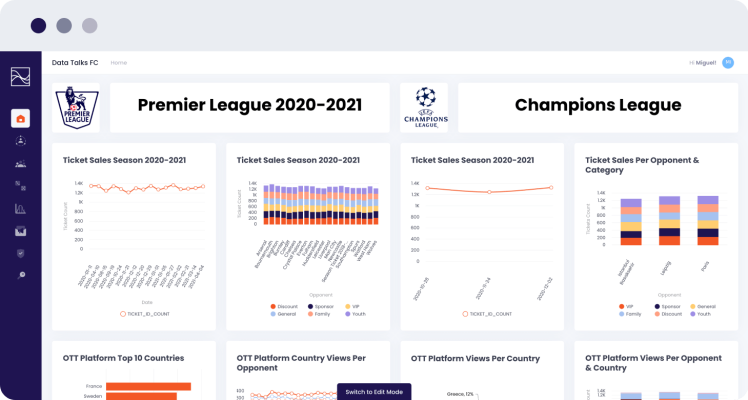The question of how to create an exceptional supporter experience for sports business is relevant now more than ever.
So, to digitalize or to not digitalize, that is the question. Then came Covid-19, and everything changed. Like many other sectors, the sports industry took a massive hit when the coronavirus struck. From postponed matches and competitions to empty stadiums and loss in ticket revenue, a lot took place. Moreover, sports clubs also noticed a drastic change in their customer behavior. This forced them to return to the drawing board and rethink their current strategies. Needless to say, a lot of questions have been raised. For example, how to adapt to this change in consumer behavior and how to leverage it. And, of course, what needs to be done to attract new customers and retain your existing fanbase. The short answer to these questions?
Before we dive right in...
Subscribe to our blog today to ensure that you never miss valuable posts such as this one. We are passionate about helping sports organizations deliver a world-class fan experience, because better fan experience means better business. So why not use this opportunity to the fullest?

Customer data
You cannot create an exceptional supporter experience for sports without data.
Data is a huge opportunity for many businesses, including sports businesses. However, many companies today don’t know how to gather their data. Neither do they know how to extract the business benefits, such as creating loyalty, engagement, and growth. Moreover, relevant and modern marketing requires a unified view of your customer data. It also calls for optimal treatment of each prospect and customer across all channels to bring about the best customer experience possible. We discussed this and more during our digital event Customer Experience Talks. During this event, thought leaders, industry experts, and digital innovators joined together to share their ideas and insights. And additionally, to discuss different questions on how your sports business can create an even better customer experience.
Key takeaways from Sports Day on creating exceptional supporter experience for sports
Bring Your Supporters Into Focus: Leverage a CDP to Boost Your Fan Engagement
This is another crucial consideration when trying to create an exceptional supporter experience for sports.
During the first session, Stefan Lavén: CEO at Data Talks, and Peter Kekesi: Sports Lead and industry expert at Data Talks, started off the day by talking about how sports businesses can bring their supporters into focus and move their fans’ attention from the competition. To accomplish this, sports clubs need to be aware of three important changes in their industry:
Covid-19
An unexpected event that has impacted companies from all sectors and forced them to rethink their strategies and tactics. More specifically, sports businesses need to move from treating their supporters as a collective, to focusing on each individual fan.
Change in consumer behavior
Covid-19 also gave a push to an already changing consumer behavior, with the new and younger generation of sports fans leading the way. Unlike their older peers, younger supporters prefer to not watch a full game, but rather the highlights. Moreover, they don’t mind multitasking and keeping up with several games at once. What’s important to remember though, is that the younger generation is still at least as engaged as the older generations, says Stefan.
Revenue generation has moved from offline to online
As a result of the changes in consumer behavior, consumption has and is still increasingly moving from offline to online. This has brought about new revenue streams.

“There is a transformation in sponsorship and more clubs are shifting focus from exposure- to activation sponsorships. In today’s world, exposure isn’t enough to stand out from the crowd, you need to “activate” your sponsorship through marketing activities in the right channels. And several of these channels happen to be online.”
– Stefan Lavén | CEO at Data Talks
Once you have recognized these changes, the next step is to adapt your strategy to them. Since the relationship between clubs and their supporters is quickly turning more omnichannel, customer data becomes essential to deliver relevant and targeted communication. A personalized relationship is needed throughout the whole year, says Peter.
Clubs, therefore, need a full understanding of their supporter base and their needs. And with a Customer Data Platform (CDP) you can accomplish this and more.
How to Convert Social Media Followers into Real Fans
In this session, we welcomed Hoshedar Gundevia: Head of Digital at RISE Worldwide Limited and Mumbai Indians, to the stage for a discussion with our Sports Lead Peter Kekesi. The topic of the discussion was how to convert social media followers into real fans, and how sports clubs can know more about, and communicate better with, their supporters.

“Despite having a great number of followers on your social media platforms, truly knowing who your actual fans are is the biggest challenge.”
– Hoshudar Gundevia | Head of Digital at RISE Worldwide Limited
During the past four to six years, we have managed to engage our fan base thanks to third-party data. But in today’s customer-centric world, this information is not enough. And more importantly, clubs need the right tools to extract the information that is actually relevant, to target their audience with the right message, Hoshudar explains.
So how do you start your digital transformation journey as a sports organization?
The first and most important step is to become “data-aware” in all areas of your business. This means understanding the potential of data, and why you need to invest in it. The next step is to take initiative and just start. Nobody knows all the necessary steps towards that journey. Find a partner who can provide you with not only a platform but also the know-how.
The wake from Covid-19: Preparing For the Reopening of Sports Stadiums in Europe
In this next session, Joeri Verbossen: Marketing Intelligence Coordinator at PSV had a discussion with Peter. The topic of discussion was sports stadiums in Europe reopening post-covid and how sports clubs can prepare for this.

“As mentioned in previous sessions, the change in consumer behavior is here to stay. During covid-19, fans have gotten new hobbies, so the question is whether it will be the same engagement in the stadiums as before.”
– Peter Kekesi | Sports Lead at Data Talks
Joeri believes that it’s possible, but that clubs need to “prove themselves” to their fans. This requires the clubs to be innovative and complement ticket sales with other exciting offerings. To achieve this, sports clubs need to focus on giving their fans an even greater customer experience beyond the stadium. So essentially clubs have to target fans with compelling content in the right digital channels. And to do so, you need the right data.
So, to be ready for the post covid era, you need to be flexible & structure your data (behavioral, ticketing, merchandising, in-stadium, etc) in a way that can be used to create a personalized experience for your supporters. A Customer Data Platform (CDP) can help you to accomplish this.
Shifting From CRM to CDP for Sports Businesses with Pantelis Parastatidis
In this session, Pantelis Parastatidis: Chief Product Officer at Data Talks, gave us a tour of the Data Talks CDP and explained: how to connect your data sources into Data Talks CDP, how to monitor your KPIs & build your dashboards, how to segment your database and how to target your audience using personalized emails.

Want to see for yourself? Take a tour of our CDP Demo for sports businesses here.
Being a Disruptor in TV Rights: How Technology, Innovation, and Digital Strategy Can Change the Landscape of TV Rights for a Club
In the next session, it was time to present Panagiotis Aroniadis: Director Of New Media at PAOK FC, to the stage to talk about how technology, innovation, and digital strategy can change the landscape of TV Rights for sports clubs.
For Panagiotis and PAOK FC, the digital transformation journey started way before Covid-19 came into the picture. It was already in 2017 that he and the team decided that they wanted to move away from traditional TV Rights and create something new, something that was their own. Shortly after, their OTT platform PAOK TV was born.
Thanks to this move, PAOK FC could exclusively manage their TV rights and broadcast their games. Having their own platform allowed them to deliver different types of content, from game highlights to behind-the-scenes clips with their fans’ favorite players.
And they didn’t stop there but decided to upscale the platform further, which landed them the prize for the digital brand of the year in both 2019 and 2020.

“Without content, you have no data. But without data, you can’t reach your fans.”
– Panagiotis Aroniadis | Director Of New Media at PAOK FC
However, at the end of the day, top-notch tech is not enough, you also need a creative mindset & awesome content to provide a great supporter experience, says Panagiotis. Because storytelling is the key to a greater fan experience. Without content, you have no data. But without data, you can’t reach your fans.
Keep Sweden Golfing: How to Engage a New Generation of Golfers (& Non-Golfers)
During this session, we invited Bo Bengtsson: Deputy General Secretary of the Swedish Golf Federation, on stage for a presentation on how to keep Sweden golfing and how to engage a new generation of golfers.
Since the early 2000s, golf as a sport has been in decline, both in Sweden and globally. But then came Covid-19, and the golf industry experienced an all-time boost and renewed interest, including a new and younger generation of golfers, with generation Z standing for 25 percent of all new members in Sweden in 2020.

“The golf clubs need to focus on engaging with their “old” golfers, and on recruiting new golf players.”
– Bo Bengtsson | Deputy General Secretary at Swedish Golf Federation
So, how do you engage a new generation of golfers in practice?
Bo says that step one is to conduct member studies and surveys on a national and local level. Step two is to analyze the collected data, from club-level data like memberships, handicaps, to analyzing big data on a federational level. Finally, step three is to act on your data and communicate targeted, relevant and engaging messages to your audience.
Working With Data: How You Can Identify the Right Vendor for Your Goal
And in this final session, we welcomed Fiona Green: Director and Co-founder of Winners FDD Ltd, up on stage to talk about how to work with your data and how you can identify the right vendor for your specific business goals.

“In the context of business, data is used in two main areas: for targeted marketing – to target prospects and customers with relevant and engaging content , and in decision-making – to make better and more accurate decisions.”
– Fiona Green | Co-founder and Director at Winners FDD Ltd
But first, you need to be data-aware, and it is especially important that the management team is on board with, and understands the importance of, data in your marketing and overall business strategy. Fiona, therefore, recommends five key elements that clubs should have in place, before embarking on their data journey:

Have a strategy in place
For data, marketing, business, etc.

Data is at the core
Make sure this is understood at all levels of your business.

Technology
It's important to invest in technology that supports your strategy and that can deliver on your goals - like a CDP

Process
With the right technology in place, analyze the collected data to find what's relevant and then act on it.

Culture
Having the right [data] culture is essential because it will enforce your strategy and push your club faster towards your goals.
Of course, in the end, the most important step is to start and become aware of the importance of data in your marketing- and overall business strategy. Building a robust data ecosystem takes time, around three to five years. But just by being aware and knowing what objectives you want to achieve, finding the right vendor becomes a much easier task.
Final Thoughts
Covid-19 has indeed forced sports organizations to take a step back and rethink their tactics and even their overall business strategy. For many, this has been a challenge. But many others also see this change as a wake-up call and an opportunity to leverage. Because if one thing is for sure, it’s that the change in consumer behavior is here to stay. And for those who adapt their approach and are aware of the importance of data, this change will be the beginning of an exciting journey.